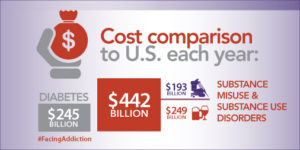At the George Rosenfeld Center for Recovery dedication ceremony, Amy, a 29-year-old Family Center client spoke about her experience at Odyssey House. Below is the text of her speech.
 Good morning, my name is Amy. I am 29 years of age. I am the mother of a beautiful 1-year-old girl. I am here to rebuild my life for both of us.
Good morning, my name is Amy. I am 29 years of age. I am the mother of a beautiful 1-year-old girl. I am here to rebuild my life for both of us.
At 22 I didn’t see my life being taken down by a medication that was supposed to help me. I had just graduated from an excellent college with a degree in psychology and sociology. My future was ahead of me and it looked bright.
Soon after I graduated college, I developed some health issues that needed surgery. The procedures were routine and I expected to make a full recovery. Little did I know then, this would be a turning point in my life.
While I was recovering from surgery, I was given opiates to manage the pain and help me recover. They did that and I definitely needed them. What happened next was so fast I didn’t see it coming – soon I was dependent on opioids for more than just physical pain – they had become my emotional support. I was addicted.
Life quickly became a wild ride of juggling jobs, losing jobs, going into short-term rehab, getting out and doing the same thing again. Each time my addiction got more serious and more damaging. I lost sight of myself, of my values, and I hurt and disappointed my family.
Within a few short painful years, I started using heroin. Heroin took over my life completely. Everything I did, every day, was to support my growing habit. Eventually, this led to an arrest and I was sitting in jail in full withdrawal. It was one of the worst experiences of my life. It was also a life-changer.
I was fortunate that my family was still willing to help me get treatment – and I needed it more than ever. Shortly after I left, I found out I was pregnant.
After speaking to countless medical professionals, I understood the only way I was going to have a healthy baby and get off heroin safely was with medication. That medication is methadone. My daughter was born with methadone in her system but she was also born 7lbs and healthy. She stayed in the hospital for a month while they weaned her off. It wasn’t easy watching her go through the pain of withdrawal, but the doctors and nurses got both of us through it. I am so grateful to them.
I am also grateful to Odyssey House and its program for women with children. It is saving my life and giving us a future. For the first time in a long time, I am incredibly hopeful, and that is because of this program. I am so thankful to be talking to all of you today on this important occasion. Thank you for supporting me, for supporting Odyssey House, and caring about the young mothers who are here now and those who will be here after me.
Thank you.





 Yesterday, Odyssey House hosted a press conference announcing a new program designed to improve addiction treatment services in East Harlem. The NYS Office of Alcoholism and Substance Abuse Services (OASAS) has awarded $190,000 to Odyssey House and Mount Sinai Behavioral Health System to support a new peer engagement specialist initiative.
Yesterday, Odyssey House hosted a press conference announcing a new program designed to improve addiction treatment services in East Harlem. The NYS Office of Alcoholism and Substance Abuse Services (OASAS) has awarded $190,000 to Odyssey House and Mount Sinai Behavioral Health System to support a new peer engagement specialist initiative. cluded OASAS Commissioner Arlene Gonzalez-Sanchez, Odyssey House President & CEO Dr. Peter Provet, and Teri Friedman, Director, Mount Sinai Behavioral Health System. The two peer engagement specialists, Anita Kennedy (Mount Sinai) and Mark Fowler (Odyssey House), also addressed the crowd, describing their experiences within the recovery community and how they plan to conduct outreach to connect individuals in East Harlem with treatment services.
cluded OASAS Commissioner Arlene Gonzalez-Sanchez, Odyssey House President & CEO Dr. Peter Provet, and Teri Friedman, Director, Mount Sinai Behavioral Health System. The two peer engagement specialists, Anita Kennedy (Mount Sinai) and Mark Fowler (Odyssey House), also addressed the crowd, describing their experiences within the recovery community and how they plan to conduct outreach to connect individuals in East Harlem with treatment services. In mid-2016, Jacqueline, 36, pregnant with her third child, nearly had to make that choice. Unable to find a program that could help her in her hometown of Boston, and desperate to get sober, Jacqueline came to New York and began treatment at Odyssey House.
In mid-2016, Jacqueline, 36, pregnant with her third child, nearly had to make that choice. Unable to find a program that could help her in her hometown of Boston, and desperate to get sober, Jacqueline came to New York and began treatment at Odyssey House. It can’t go on. The death rate from what is a preventable, and treatable disease, is unconscionable. The financial costs are unsustainable.
It can’t go on. The death rate from what is a preventable, and treatable disease, is unconscionable. The financial costs are unsustainable.